Hello everyone. I'm glad to participate in another season 3 homework given by
@imagen. He explained many things about staking and we were given homework to test our ability whether we understand the topic treated, and here is my input. Please stay with me through this little time. Here are the questions given by professor
@imagen
1.) Research and choose 2 platforms where you can do Staking, explain them, compare them and indicate which one is more profitable according to your opinion. (Binace is not allowed)
2.) What is Impermanent Loss?
3.) What is Delegated Proof of Stake (DPoS)?
4.) Conclusion
Introduction
Cryptocurrency came into existence a few years ago (1999) to be precise and the first coin was BItcoin. The only way Bitcoin circulated was through mining. And till now, mining still continues, but this is done through a very tough means. When I say tough means, I mean not just anyone can easily mine bitcoin because of the steps and processes involved. In other to understand staking well, let's begin with what lead to staking and that would take us a little bit into Bitcoin, Proof of work, and proof of stake
Staking
Bitcoin and other decentralized cryptocurrencies are designed in a way that when they are sent to anybody digitally, no central authority is involved. The solution created to managing a blockchain was done through mining where powerful computers set up by validators were used to solve mathematical calculations and however gets the solution to gets rewarded and such person stand the chance to create the next block or write the next page of transaction on the ledger of balance.In bitcoin mining, the more powerful your computer is the higher your chance of winning the contest. This is where the proof of work sets in
Proof of work
Because the miners put in a lot of work to solve the problems before creating a block that would release bitcoin from the mining pool as a reward, they classified it as a proof of work, and this is also known as a consensus mechanism. Because there is an agreement as to who gets to update the ledger among the group of people managing the nodes anonymously without seeing each other. The proof of work consensus mechanism is a reliable and secure way of managing a decentralized ledger, however, it's very resource-intensive because the amount of electricity needed to keep the supercomputers working 24/7 just to guess a solution to a mathematical puzzle is much, among other disadvantages. So because of all these disadvantages, other consensus mechanism was put in place to reduce the cost of mining and it's efficiency, and this leads to coming about the proof of stake
Proof of stake(This the birth of concensus mechanism with less resource intensive)
So instead of using supercomputers and other gadgets to mine, staking coins became the alternative way. This is done by depositing a fund on a network computer. The fund is your cryptocurrency, which is also your stake, and the node is the computer. Once your stake is in place, you automatically take part in the contest of which node would forge a new block. In POW, blocks are formed, but in the case of POS, stakers forge blocks. They don't mine. It's the stake that does the work and not the staker, so every reward gotten from what is staked is likened to the reward gotten from mining. The only difference is that miners use computers and other gadgets to mine, which is very expensive to set up, but stakers use their coins to stake and get rewards from the pool. So staking can be defined as the process of locking up your cryptocurrency in a smart contract in other to help secure crypto networks without consuming much energy and at the same time getting reward for contributing to the system
Advantages of POS
Proof of work solves scalling issue which POW couldn't solve: Larger user can work together to run nodes, since there is no huge eqipment needed, and this helps to salter the rate of transactions without comsuming much energu
No purchasing of Huge hardware
Reward: Unlike the POW mechanism, POS offers stakers a fixed percentage of transaction on the network no matter the rate of the processing power.
Different types of staking
We have
Proof of stake (POS), which is the first of all. As discussed before, every staker that is forging the next block is selected through random selection based on their stake, and not based on computing power as it is done in POW. So ina nutshell, we can say, with POS, anyone can stake coin using their wallet. Example, Peercoin, SproutsCoin etc.
Delegated proof of stake (DPOS) : Here, there's selection. I ill explain further when I tackle the question that deals with it.
Leased proof of stake (LPOS) : This has a kind of similarities with the master node proof of stake, but they are still different. Here, leasers lease their token to miners the return gotten from the miners mining nodes is distributed between himself and all the leasers. Users can get reward from his leasing without mining for himself. Another miner does the job, and he get his own share of the profit.
One of the platform that does that is the wave platform. They support LPOS. All LPOS users can lease their wave coin to other users handling a full node, because users without much coin can't control any node. Only the high users are given the priviledge to have a node they control and the leasing of coin to the high users that own a node is called account-leasing. It should be noted that in LPOS transactions, two things are involved
1
The lease transaction where the leasing process is activated. Here, the user or the token holder initiates a leasing transaction by specifying the node adress of the recipient and the amount to be leased and the transaction is completed
2
The token holder might feel like unleasing his fund, and at this point, he can cancel lease transaction and end the leasing journey. The rewards recieved on LPOS is not from the pool. Yes, that's one difference it has compared to others. Reward is generated from the transaction fees to pay leasers after a new block is created. One future I was able to note on LPOS is simlar to delegation on steemit. When you delegate to users on steemit, the user cannot tamper with your token. They can only utilize it, and when you are ready to undelegate, you don't need a permission to do so. In LPOS too, the leased tokens cannot be traded or transfered unless the leaser unlease and make use of it as he wants
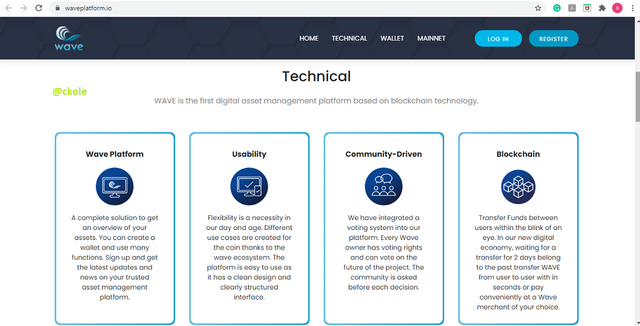.png)
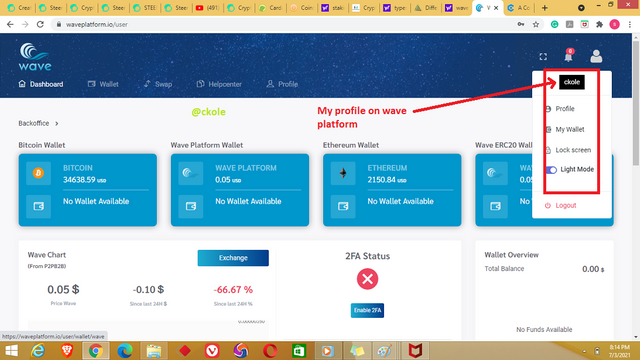.png)
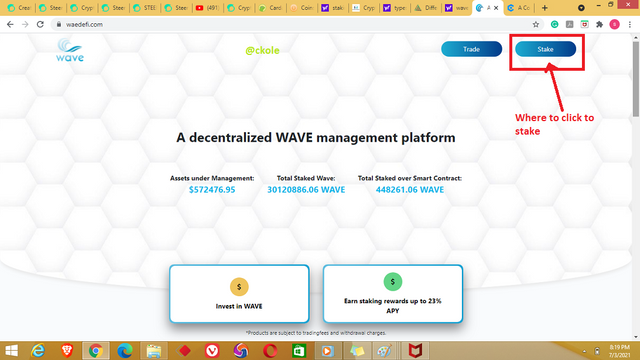.png)
- Master node proof of stake : People running this node are seen as a whale because they have the largest stake on the platform. On mater node proof of stake, there is a minimum amout that a user must stake to merit the master rank, and it's always a large amount. Anyone that merit the master node height is always seen as trustworthy and reliable, so to merit that level, you must have a huge stake on the platform, and must be verified. Platforms that practice the master node are DASH, PIVX, XZC and so on.
What about stake as sevices platforms and exchanges that offers staking?
Exchanges that offer staking
- Coinsbit
- Binance
- Poloniex
- Kraken
- Coinbase
- Kucoin, and so on.
Research and choose 2 platforms where you can do Staking, explain them, compare them and indicate which one is more profitable according to your opinion
I will be explaining two platforms namely
I will explain them based on my experience.
Coinsbit is an exchange where you can stake different types of coins. It was created in 2018 and won the best cryptocurrency exchange award launched in 2018. Coinsbit has a processing speed close to 10,000 trades per second up to 1 million TCP connections. For security purposes, more than 95% of all currencies on coinsbit are stored in a cold wallet, and the use of WAF (Web application firewall) makes hackers find it difficult to tamper with the system
How the stake on coinsbit
Having an account with coinsbit is the first procedure and it's advisable to verify the account before doing anything because of some limitations that can be encountered if KYC is not done. We should bear in mind that Coinsbit is a centralized exchange. I will go through the steps I took when I staked my CNG token some months ago and I will show the profit I've generated within that period
- To stake on coinsbit, you need to buy the token you wish to stake.
There are many coins on coinsbit that can be bought and staked. You can start staking by clicking on the staking pool as shown in the image below.
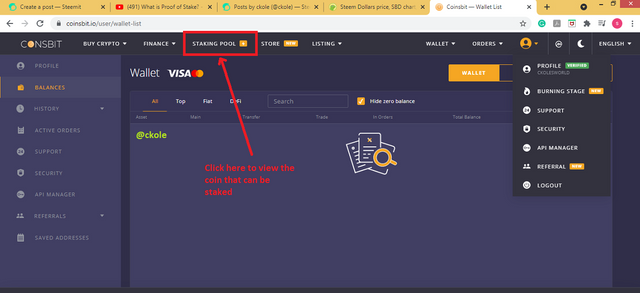.png)
- After clicking on the staking pool, you will see differnt coins in the pool. You can then click on the one you wish to stake. I clicked on CNG to show how it's done. So click on staking.
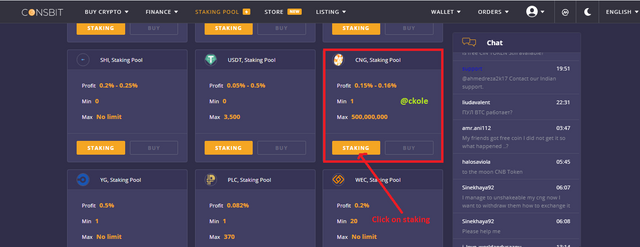.png)
- After clicking on staking, it would display another page where you will need to select the type of staking ypu want. Coinsbit do it in such a way that you can choose whether to hold your token, or hold and be disallowed to withdraw for a particular period. The profit that comes with these options is different. From the image below, you would see that the first one comes with 0.150%, while the other one is 0.160%.
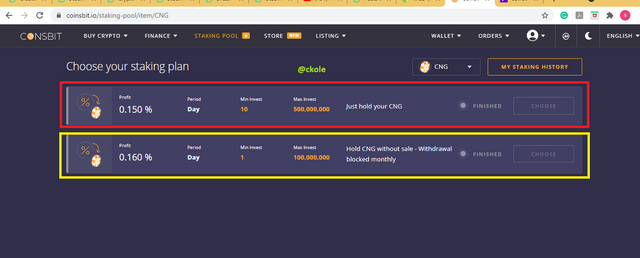.png)
- The next thing is to click on choose, and input the value of the coin you want stake in the box and click staking
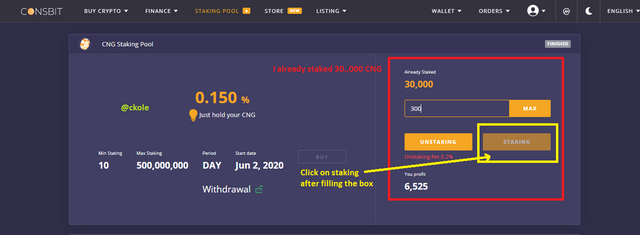.png)
From the image above, I'm having a profit of 6,500 that accumulated over time. That's part of the benefit of staking.
Kraken
To stake on Kraken is an exchange
Sign up on their platform, and verify your account to have access to more futures
click on staking on the nav bar (You will see many cryptocurrency you can stake)
Click on the three dots at the front of any coin you want to stake and from the drop down, select ADD ASSET.
Then enter the asset amount to stake
And click on stake.
In the case of polkadot, the reward would be paid out twice a week with a yearly reward of 12%. Make sure the GROW REWARD feature is turned on, in other for your reward to be reinvested in your staking.
Images
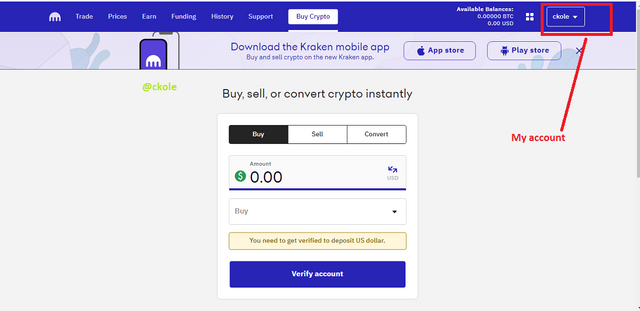.png)
Comparing Coinsbit and Kraken
These platforms are differnt and they have their ways of doing things. I've staked on coinsbit and to be candid, I like the way they operate. Ever since I've staked my coin, I've not been deprived of my reward for a day. The platform has been providing the right information neded to keep all stakers abreast of all their moves, so I would say
- They are to a reasonable degree reliable
- They have a good APY offer. I recieve 45 CNG daily on my 30,000 stake, and that is a good offer
- They are always working to improve, and they take the security of their users seriously
-Another thing is the ease of use of the platform. No matter how good or fantastic a platform is, if the interface is not user friendly, users will shy away from it.
I think I like coinsbit staking platform and prefer it well. Kraken platform is also nice and unique, but one thing that made me detest it is that when you stake your ETH, you don't know when you will have the chance to unstake. It's not clear. I think that is one part I think they can work on asap. Apart from that, it's also a good staking platform to try
What is imparmanent loss
I will like to explain this with an example.
L
et's make an assumption that there are 1000 steem and 1000USDT in an asset pool, adn the price of steem and USDT are the same, say 1 steem - 1 USDT, then Mr. John, a LP contributed to the pool with 200 steem and 200 USDT. It means the whole steem and USDT would amount to 1200 each. This implies that Mr.John owns 10% of the asset in the pool, which is 400 USDT in total
If the person that deposited 1000 steem and 1000 USDT withdraw like 200 steem, thecalculation according to Constant Product Market Maker(CPMM) would be [1200-1,000,000/1200] = 366.66 USDT, and the price of teem too would have reduced by that time. So in this case, there would be 1,200 Steem and 834.34 USDT in the pool, and if Mr.John wants to take his 10% out, by removing his liquidity, he won't get the total amount of what he invested because the imparmanent loss has eaten part of his asset. However, this mostly occur at the inception of the market making
If the Liquidity provider didn't pull off his asset, the trading fee generated would gradually make up the loss, and as the price of the asset goes up, the loss wold be recovered. So simply put, when the multiple token required to provide liquidity start loosing it's value after an Lp has staked his coin, Impermanent loss has set in
What is Delegated Proof of Stake (DPoS)
Dan Larimer was the person that came about DPOS some years back, and if we look at the popular platforms that run DPOS, Steem and TRon is one of them. The delegated proof of stake involves the selection of some particular people to run the nodes on the blockchainthrough a voting system. Example of DPOS very close to us is the steem blockchain, where users vote for witnesses to set up a node to maintain the blockchain and achieve concensus during the formation of new blocks. All these 20 witnesses are the heart of the blockchain because if they fail to perform their duties as elected representative to keep the blockchain active, there would be issues, and that's why anyone that's not active is voted out and replaced. One strong advantage of DPOS over other concensors mechanism is speed. As far as I know, Steem has one of the highest speed when it comes to speed. It can process a lot of transactions per seconds compared to other mechanisms
Conclusion
Staking has helped many people to recorver their loss during financial melt down. When the price of an asset drops drastically, the reward generated from the pool would help recover gradually. Besides, that, it has helped the crypto sphere to have more liquidity. More people would like to stake and this helps the price of various cryptocurrency because the circulation would reduce when there's more people holding
The POW played a great role, but the POS has changed many things so to speak. The computing power needed to create blocks was reduced to a mere staking of coin that does not need huge tools and much electricity. I'm optimistic that the POS would keep improving as the world of crypto keep expanding. This is a very educative topic given by
@imagen. Much regards professor and thank you for the wonderful lecture
Thanks for reading.
Cc: @imagen

.png)
.png)
.png)
.png)
.png)
.png)
.png)
.png)

Hi @ckole. Thank you for participating in Season 3 of the Steemit Crypto Academy.
I congratulate you, you did a good job and you show mastery of the topics requested in this assignment.
I hope to continue correcting your next assignments.
Grade: 9.0
Thanks professor for the review. I appreciate your response to my homework. Looking forward to participate in the ongoing homework. One love.